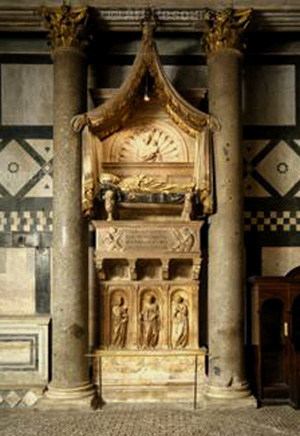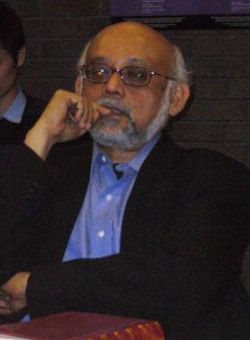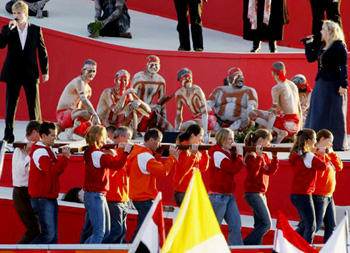 |
Consequences of Vatican II
The Progressivism of the
First and Second Renaissances
Lyle J. Arnold, Jr.
In his book on Catholic history, Thomas Bokenkotter wrote about the delight of progressivists on hearing of the election of the future Paul VI after the death of the ‘second’ John XXIII: "It was with a sigh of relief that the progressivists learned of the election of John Baptist Montini as (John XXIII's) successor, a progressivist obviously committed to the Johannine revolution."(1)

The "Johannine revolution" began with Vatican II |
The "Johannine revolution" began with Vatican II. In Volume I of his collection Eli, Eli, Lamma Sabacthani, Atila S. Guimaraes points out two vital principles that were unleashed by the progressivist spirit of that Council. First, the Council teaches "a particularly broad mercy toward the world and (its) false religions," and second, it promotes "tolerance toward the world and the false religions and opposition to Catholic militancy."(2)
Mercy and tolerance are two dispositions of soul required in us by God, but they must conform to the order of grace. To do this they must be grounded in the cardinal virtue of Prudence, which requires of us "right reason...with respect to the end" (3), which we find in what Holy Mother Church proposes. The worship of "strange gods" in false religions constitutes a sin against the First Commandment. The Prophet Elias made it very clear that man must take a clear position and not halt in a middle position "between two sides" (3 Kg 18: 21).
Guimaraes demonstrates the change of stance the Church took after Vatican II, for the first time in History announcing she should adapt to the changing world:
"Consistent with the philosophical principles of evolutionism, most progressivists argue that the Holy Church should always adapt her structure, laws, customs and even her moral and dogmatic doctrine to the demands of the times. If she fails to do this, they say, she will betray her mission as the ‘sacrament of the world.’ To be aggiornata she should rid herself of all that represents the times past and that injures the egalitarian and liberal sensibilities of the 20th century." (4)
The key phrase here is “ridding herself of all that represents times past." Two major success stories of the application of this doctrine were the elimination of Scholasticism and the Mass. Those in the traditionalist camp need no account of this here. In addition, there was the systematic destruction of Church art and architecture, which exert powerful influence on the laity, speaking as they do to the hearts of men.
The ‘first’ Renaissance and the ‘first’ John XXIII
On this subject it is useful to look at the first Renaissance and the Medici family, the "godfathers" of that dangerous rebirth of Greek and Roman culture in Italy, which took place under the influence of pagan Humanism.

Medici's grandiose tomb for their puppet,
antipope John XXIII |
Carried away by a lust for power, this family came to be called "the taste makers" of Florence. They sought to change not only the culture nurtured by the Middle Ages, but to control the papacy to achieve their ends. Thus, in the early 15th century, they supported for the papacy Baldassare Cossa, an ecclesiastic described as "a corsair in the war between Louis II of Anjou and Ladislas of Naples." (5)
Cossa had the ignominious distinction of being the first John XXIII between 1410 and 1415. He was charged with piracy, murder, rape, sodomy and incest, and deposed as an Antipope, although he was buried by the Medici in a grandiose tomb. He was a tool in Medici hands to destroy medieval culture and morals, and inaugurate a new culture with roots in the vices of Antiquity.
Seeking to establish an incipient Progressivism in the culture of that time, the Medici also supported Filippo Brunelleschi, the one who effectively created the transition in architecture from the Middle Ages to the Renaissance (6). Fascinated by the classical and pagan Pantheon, the "house of gods," Brunelleschi imitated it to complete the cupola of the Florence cathedral, which carried the same "spirit" as that of pagan Rome, the very mistress of error.
The Medici also pushed their revolution into the realm of art, through the profane works of artists such as Sandro Botticelli, whose style would dominate the last quarter of the 15th century in Florence. His message was that "a harmonious relationship between human beings and the world can only be achieved through the triumph of reason, intelligence and beauty over brute force and arms" (7). Sensuous in the extreme, his works represent well the new mentality of the Renaissance that sprang from the disastrous victory of the desire to enjoy life's pleasures over Catholic militancy and the austerity of the Cross. (8)
By its intrinsic nature, culture has a profound influence on the human soul, and this first Renaissance changed culture. Culture is, indeed, the very “life-blood of a people, the flow of moral energy that holds society intact." (9) To change culture for the worse is to release poisonous fumes into the moral oxygen of a people, and a grave sin. This is what happened in the first Renaissance. But it was only the beginning. The second Renaissance came about in the middle of the 20th century.
The ‘second’ Renaissance and the ‘second’ John XXIII
Angelo Giuseppe Roncalli, the second John XXIII could not have picked a more appropriate name for the mission he was to accomplish. The fact that there were a number of Popes named John during the first 1400 years of the Church and then no more for over 500 years is probably due to the controversial figure that Antipope represented. After he was deposed, no Pope wanted to take that name again. It was a surprise and shock to many when the good-natured Roncalli picked the name John XXIII, given the first John’s bad end.

Gramsci, indirect architect of today's cultural revolution in the Church |
While the first John XXIII reigned during the first Renaissance, with its rejection of the Gothic, the second John XXIII went much further in the realm of culture. Although the Medici revolutionized culture, the liturgy at least was left intact. Today, thanks to Vatican II and the legacy of "good Pope John" and his open windows, we have the utilitarian, shtick liturgies that are stripped of sacrality and beauty.
The incipient Modernism of the first Renaissance inched forward through the next centuries, showed its head more brashly in the 19th century, and finally surfaced as Progressivism in the 20th century, becoming a bold public movement after Vatican II. While it was the Medici who brokered the Renaissance, it was the ideas of Gramsci that permeated the Council.
Antonio Gramsci was an Italian Marxist theorist, who stressed culture as the key to lead the West to Communism. According to his formula, Christianity had to be secularized, and culture and morals corrupted, for the Revolution to succeed peaceably in the West. (10) The means for this transformation was for the Church to adapt herself and her teachings to the errors of the Modern World. The tool to achieve this was Vatican Council II.
Two points are of interest here. The first is that Vatican II was silent about Communism. Applying the maxim qui tacet consentit [he who remains silent consents], the periti at Vatican II can rightly be indicted of complicity with Communism, especially in view of the Fatima message with Our Lady’s warning about the errors of Russia.

The cultural revolution progresses: painted semi-nude natives onstage at the opening Mass at WYD-2008 |
Second, we find that today the vulgar, immoral and egalitarian spirit of the Cultural Revolution has instilled itself in the entire Church. Today we witness the triumph not only of the Gramscian formula of secularizing culture, but a trans-Gramsci code of blasphemy. Consider, for example, the speech of Fr. Richard Sparks CSP (supposed expert on Bishops’ sex education) during his address at Cardinal Mahony’s Religious Education Congress in Los Angeles:
“If you can’t fantasize Mary and Joseph having sex … okay where did all those brothers and sisters come from? … Do you think Joseph ever wanted to jump on Mary’s bones? Do you think Joseph ever thought, God, why can’t we consummate this thing? … Did he ever sorta fondle his wife? Did she ever kind fondle him? … If that sounds dirty or bad, then it probably says you’ve got some hang-ups about your own embodiment and sexuality.” (11)
Unfortunately, examples of such blasphemies are legion today. One can only wonder how long Our Lady will allow the progressivist revolution to go on, promoted by the very heads of the Church.
1. Thomas Bokenkotter, A Concise History of the Catholic Church (NY: Image Books, 1979), p. 416.
2 In the Murky Waters of Vatican II, (now in its third edition) (Los Angeles: Tradition in Action, 1997), pp. 38-39.
3. Parente et al, Dictionary of Dogmatic Theology (Milwaukee: Bruce Pub., 1951), p. 294.
4. Animus Delendi – I (Desire to Destroy), p. 85.
5 Michael J. Walsh, ed., Lives of the Popes (NY: Barnes & Noble/, 1998), p. 186.
6. Laurie Schneider Adams, Italian Renaissance Art (Boulder, CO: Westview Press, 2001), p. 66.
7. Stefano Zuffi, One Thousand Years of Painting (Milan: Electa, 2004), p. 87.
8. Plinio Correa de Oliveira, "The Role of Economy in the Collapse of the Medieval Mentality," Organic Society on Tradition in Action website, 7-2-08.
9. Roger Scuton, An Intelligent Person's Guide to Modern Culture" (South Bend, IN: St. Augustine's Press, 2005), p. 1. Author was quoting Johann Herder.
10. Catholic Family News, December 2001, pp. 22, 23.
11. Ad Maiorem Dei Gloriam (Roman Catholic Faithful, 2004), p. 23.

Posted July 17, 2008

Related Topics of Interest
 The Pact of Metz The Pact of Metz
 John XXIII Receiving Protestants at the Council John XXIII Receiving Protestants at the Council
 The Incorrupt Pope and the Pharaohs The Incorrupt Pope and the Pharaohs
 The Growing Rejection of Vatican II The Growing Rejection of Vatican II
 Liberals, Modernists and Progressivists Liberals, Modernists and Progressivists
 Revolution and Counter-Revolution in the Tendencies Revolution and Counter-Revolution in the Tendencies

|
Vatican II | Hot Topics | Home | Books | CDs | Search | Contact Us | Donate

© 2002-
Tradition in Action, Inc. All Rights Reserved
|
 |
|